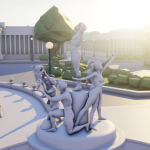
Resilience and Utopia
Miami, as an ECC exhibition in the context of the Art Basel
Resilience speaks of how space is perceived by its inhabitants, and how spaces designed for communities reflect this, particularly their symbolic properties as ideal spaces for communal living.
Taking this as general background, resilience is usually associated with things other than utopia. At first glance, resilience and utopia seem contradictory to each other. Resilience is conceived as the ability to withstand disturbances and to return to a former state of existence conceived as ‘better’, more stable and more desirable than the one existing in that particular moment. Resilience can be described as a capacity to persist, adapt or transform in the face of change, in a way that maintains the basic identity of a system.
From this perspective, resilience is essentially backward-oriented, as it describes a desire to achieve an ‘ideal’ state, which existed in the past and was subsequently lost. In this way, the very idea of resilience relates to a ‘back to the root’s movement: a return to one’s identity, as a new base for viability and survival. By contrast, utopia is usually associated with progress, future and forward-orientation: the very opposite of a backward-orientation. In such a move towards the future, the creation of new identities is sometimes possible.
Nevertheless, resilience and utopia share similarities in some respects: in the feeling of loss, and in the need to overcome a present state of existence. Common to both resilience and utopia is a longing for something better, a desire to overcome the present; this is, in essence, a utopian venture. And despite having its anchorage in the past, the longing for resilience becomes future-oriented because now, at this particular moment in time, there is no resilience anymore; we must first regain it. As a utopian venture and in mythological terms, resilience refers to a past golden age. It resembles the Christian myth of a paradise lost.
What do spaces for resilient communities look like? There is a multitude of possible spatial constructions. Imagine a large canvas on which alternative worlds come to life. For instance, a project by our collaborator in Miami, Jateen Lad, and his Sharanam Centre for Rural Development, to be exhibited at the FIU in Miami; or projects by the Ideal Spaces Working Group itself.
A key example is our fictitious or “utopian” world, which is divided into terraces, presenting spaces in which communities can settle and lives unfold.
These communities have their own type of social organization and architecture, both of which depend entirely on the community in question. The overall aim of this world is to achieve maximum diversity and autonomy for the different communities, thus ensuring maximum resilience by dispersing these values throughout various autonomous places. This is only one example. One can imagine other “future” worlds in which resilience, the longing to regain one’s own identity, could be achieved.
